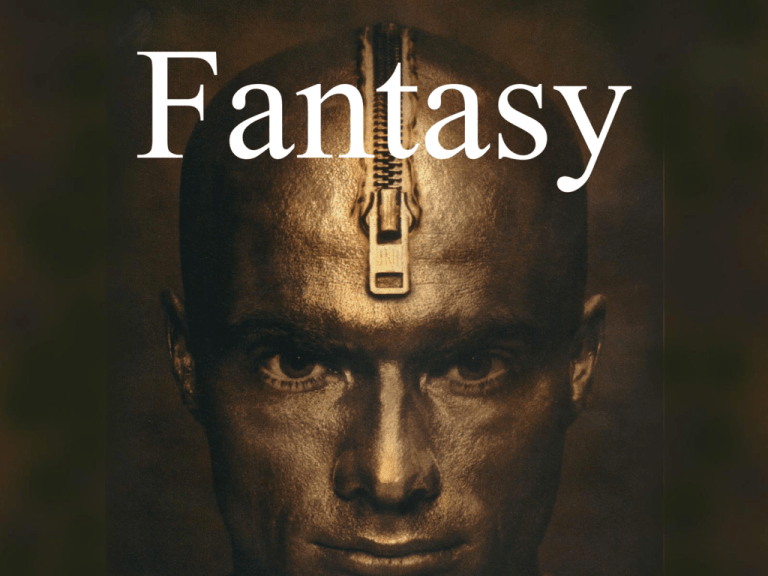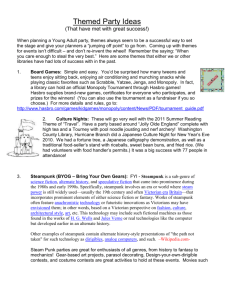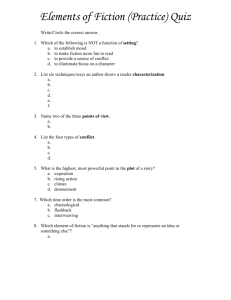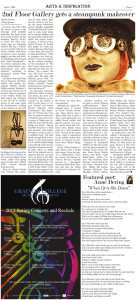Surrealism Fantasy
advertisement

Fantasy Surrealism Part I “Have you ever had a dream you were so sure was real? What if you couldn’t wake up? How would you know the dream from reality?” What is Surrealism • Surrealism is the expression of the dream state or the human unconsciousness. Surrealism put normal “things” in an abnormal context. • Surrealism relies heavily on the ideas of Sigmund Freud and the study of psychology. – These include the concepts of psycho-analysis and the interpretation of dreams as keys to understanding the self. Salvador Dali • Spanish painter and writer who joined the Surrealist movement in the 30’s. • Work deals heavily with the ideas of psychosis and sexuality. Psycho-analytical method • Dali began working in this method by painting his dreams and hallucinations. – Freud’s “Interpretations of Dreams” stated that by understanding the symbolism of dream imagery, you could gain greater understanding of a person. Paranoiac-critical method • Dali attempts to show different images within a single painting. • The idea is to create a feeling of psychosis or a dream state in the viewer. – Dali wanted people to think they were seeing things. Rene Magritte • French Surrealist, one of the original founding members of the movement. • Makes extensive use of the “nonsensical association” and missed perception. Suspension of reality • Magritte uses the idea of dream imagery to create illusions which at first glance appear normal, – but upon close examination are clearly unreal. • He is know for the use of very subtle and intelligent illusions. Nonsensical associations • This is the idea that by placing objects together, which in reality have absolutely no connection, the artist can force people into finding a relationship. Style • The Surrealists initially adapt of more stylized method of painting characterized by Magritte. • Dali’s use of “classical” highly realistic painting is part of what gets him banished from the movement in the 30’s. – This classical style of high realism becomes the style of choice for most Surrealists in later years (with the development of better photography and computers). Dave McKean J.K. Potter Jerry Uelsman Storm Thorgerson graphic designer - Pink Floyd Thorgerson uses no computer manipulation to achieve his surreal illusions, only standard photography. Thorgerson also uses the great Surrealists of the past as inspiration for some of his work. Magritte Dali DiChirico Some commercial applications of the Surrealist theory... Fantasy Part II “Have you ever had a dream you were so sure was real? What if you couldn’t wake up? How would you know the dream from reality?” What is Fantasy ? • Fantasy is different from surrealism in that it is the creation of something that in theory can never exist in reality. • There are many different categories of fantasy, but major themes are the supernatural (ghosts), mysticism (religion) and science-fiction. – The first two have been around as long as man, but science fiction has only been around since the industrial revolution, and has many sub-categories. Jheironimus Bosch • Worked during the 14th and 15th centuries in Germany. • Know for large and incredibly detailed paintings of religious subject matter (specifically heaven and hell). Archimboldo Mysticism Part III “Have you ever had a dream you were so sure was real? What if you couldn’t wake up? How would you know the dream from reality?” Super Natural (Horror) and Mysticism • Any work that has its foundation in religion, mythology and the supernatural falls into this category. – Definitions in this category can get “fuzzy”, as what one person thinks of as mythology may be another’s religion. Gustave Dore Fuseli’s “Nightmare” (horror) Science Fiction Part IV “Have you ever had a dream you were so sure was real? What if you couldn’t wake up? How would you know the dream from reality?” What is Science Fiction? • Science fiction deals with imaginary but more or less plausible content . • This includes future settings, futuristic science and technology, space travel, aliens, and extrasensory abilities (ESP etc.) . • Exploring the consequences of scientific innovations is one purpose of science fiction. Science Fiction • Science Fiction has only been around since the industrial revolution. • It had a huge surge in popularity however, in the 1940’s… – With the dropping of the atom bomb. • …and again in the 60’s – With the launch of Sputnick and the space race. Within sci-fi art, there are many classifications of different types of styles… SPACE OPERA… As typified by work like Star Wars and Star Trek. clean, bright, shiny high tech and utopian CYBER PUNK… As typified by work like Alien, The Matrix and Blade Runner. dirty, dark, grimy high tech and dystopian Science Fiction (on Wikipedia) Some material can cross platform – being space opera in aesthetic but punk in mood or theme… Some work defies easy classification… It can fit into more than one sub genre or classification. Is this sci-fi, fantasy, horror, supernatural? Steampunk • Steampunk is a subgenre of sci-fi which came into prominence during the 1980s and 1990s. • It incorporates elements of science fiction, fantasy, alternate history, horror, and speculative fiction. Steampunk • It is an alternate reality where steam power is widely used to run advanced technology, usually… – Victorian era Britain or – "Wild West“ era United States. Works of Steampunk feature anachronistic technology, or futuristic innovations set in a Victorian time period and aesthetic. Think of it as a world where today’s technology existed 100 years ago, but steam powered. Frankenstein; or, The Modern Prometheus is a novel written by Mary Shelley . The novel, about a monster produced by an unorthodox scientific experiment, is often referred to as the quintessential Steampunk novel. Thomas Edison actually produced one of the first film versions… Thomas Edison’s Frankenstein DARPA is actually creating mechanical insects for use by the military… Jules Verne Jules Verne is one of science fictions early pioneers with his Voyages Extraordinaires series of novels that included Around the World in 80 Days as well as From the Earth to the Moon. H.G. Wells H.G. Wells wrote a series of novels referred to as his fin de siecle novels including The War of the Worlds and The Invisible Man. Michael Parkes Steampunk on wikipedia Paul Guinan’s Boilerplate, a 'biography' of a 19th century robot, started as a website. People began to believe that Photoshop images of the robot with historic people were real. The site was eventually turned into an illustrated book Boilerplate: History’s Mechanical Marvel. Because the story was not set in an alternate history, and contained accurate information about the Victorian era, the book is often referred to as "historical Steampunk." Boilerplate – Mechanical Marvel of the 19th Century. On a related note… H.R. Giger • Contemporary Swiss artist, creates quasireligious and heavily sexual work in the tradition of Dali. • Created the science fiction style called… – “bio-mechanics” and is best known for the movie Alien. • His Biomechanics concept can be compared to Steampunk. – Why is it comparable? This painting was the inspiration for the monster in the movie “Alien”. Your task you ask? Your task you ask?








